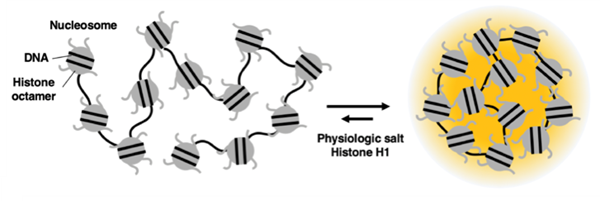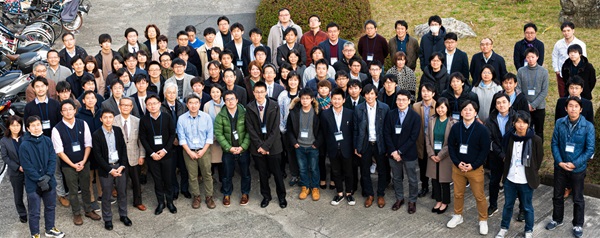Phase separation phenomena exist in all modern cells and play integral roles in regulation and catalysis of biological systems. To date, there has been much research done on various aspects of phase separation, including in the fields of genetics, cell biology, biophysics, prebiotic chemistry, and methods development, but rarely have all of these aspects been consolidated. Here, the authors present a unified review of the recent major advances in phase separation and discuss how the application of available cutting-edge technologies towards phase separation research will advance the field of biological phase separation research in Japan and around the world.

In recent years, phase separation phenomena have come to the forefront of various biology-related research fields. Although it can be observed using simple everyday items, such as oil and water, its significance in biology is not to be understated; biological phase separation plays integral roles in regulation and catalysis in modern biological systems, as seen with numerous discoveries of cellular membraneless organelles. A great deal of research has been performed in genetics, cell biology, prebiotic chemistry, and biophysics, and many advanced analytical techniques have been developed to study these processes in cellular systems. However, given the diversity of the techniques used and the fields interested in phase separation processes in biology, there has been no major unifying force towards the coalescence of various fields related to biological phase separation.
In this review led by Takuya Yoshizawa of Ritsumeikan University – part of a special issue of Biophysical Reviews focused on science presented at the 2019 Biophysical Society of Japan Annual Meeting – the authors, including Tony Z. Jia of ELSI, combine various aspects of biological phase separation. The authors begin by outlining various cellular biological phase separation processes, including their regulation and assembly, and discuss how some of them can contribute to various known human diseases. Many of these processes involve the regular function of a cellular membraneless organelle called RNA granules; when the function, regulation, or formation of these membraneless organelles becomes abnormal, many diseases arise such as dementia and amyotrophic lateral sclerosis.
The authors next discuss recent research – performed by co-author Ryu-Suke Nozawa of the Cancer Institute of the Japanese Foundation for Cancer Research – suggesting that chromatin, often believed to be a regularly packaged intranuclear structure, is actually the product of a complex phase separation process. These chromatin structures behave much more like liquid phase-separated droplets, and have a major role in the regulation of cellular processes. Recently, there has even been renewed interest in studying phase separation phenomena in prebiotic chemistry as a method towards primitive compartment assembly. The authors then discuss various model phase-separated systems used in the laboratory to simulate primitive compartments, and how these models could directly link prebiotic chemistry and modern biology.
Finally, the authors end with a discussion about recent advances in analytical techniques used in biological phase separation research, some pioneered by co-author Tomohide Saio of Hokkaido University, and discuss the necessity of continuing development and novel approaches towards future research in this field. These techniques range from spectroscopy, microscopy, and other physical techniques, and the sheer breadth serves to show that understanding phase separation processes requires a concerted, interdisciplinary effort from researchers.
In Japan specifically, there has been renewed interest in biological phase separation in recent years, although the most significant discoveries are still taking place internationally. However, labs in Japan have access to some of the most cutting-edge analytical technologies in the world, such as small-angle neutron scattering and high-speed atomic force microscopy. These techniques are poised to contribute greatly to significant phase separation research going forward. With the recent excitement about phase separation in Japan, and the ability to utilise the most cutting-edge instrumentation and technology, the co-authors joined a large and diverse interdisciplinary research collaboration team to continue pushing the boundaries of phase separation biology in Japan in order to stand equally on the global stage.

To further promote interest in phase separation research in Japan, co-author Yoshizawa, corresponding Author Eiichiro Mori of Nara Medical University, and their collaborator Kentaro Shiraki of Tsukuba University have been organising a series of phase separation meetings in Japan over the last few years. The current level of interest in biological phase separation phenomena could be seen at the 4th Liquid-Liquid Phase Separation Research Conference’s ASUKA Workshop for Young Scientists held at Nara Medical University, Kashihara, Nara, Japan in December, 2019, which was attended by all co-authors and co-organised by lead author Yoshizawa and corresponding author Mori (co-author Saio was part of the programme committee). In just one afternoon, over 100 participants presented more than 30 studies, with most of the attendees being either students or early-career researchers/postdocs. Mori, also the leader of the collaborative team, thinks that now is the time to take advantage of the numerous technological advances in Japan and apply them to important unanswered questions in phase separation research. This way, we can make the recent renewed interest in phase separation into tangible and significant research.

| Journal | Biophysical Reviews |
| Title of the paper | Biological Phase Separation: Cell Biology Meets Biophysics |
| Authors | Takuya Yoshizawa1, Ryu-Suke Nozawa2, Tony Z. Jia3,4, Tomohide Saio5, Eiichiro Mori6 |
| Affiliations |
|
| DOI | 10.1007/s12551-020-00680-x |
| Affiliations | 18 March, 2020 |
